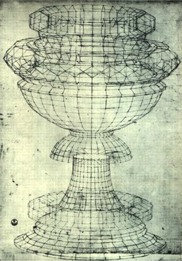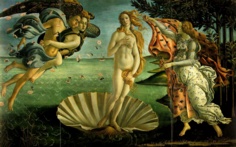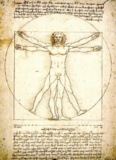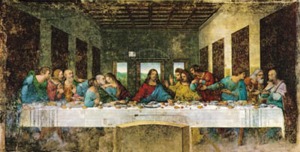
Donatello (born as Donato di Nicolo Bardi) (Italian, 1386-1466), Virgin and Child, Florence(?), around 1400, polychromed terra cotta relief, 1.02 x 0.74 x 0.12 m, Louvre. See frame and Madonna. See a Donatello site [text in Italian].
"Fra Angelico", Guido di Pietro da Mugello (Italian, 1387-1455).

Paolo Uccello (born Paolo di Dono) (Italian,
1397-1475), Perspective
Study of a Chalice, pen
and ink on paper,
29 x 24.5 cm, Gabinetto dei Disegni, Uffizi, Florence. See chalice and wireframe.

Andrea Della Robbia (Italian, Florence, 1435-1525), Virgin, from The Annunciation, c. 1475-80, lead-glazed
terra cotta, height
56 inches (165.1 cm), (other figures
— Archangel Gabriel, God the Father, and Dove of the Holy Spirit — not illustrated). Los Angeles County Museum of Art.

Andrea Mantegna (Italian, Paduan, c. 1429-1506),
The Adoration of the Shepherds, shortly
after 1450, tempera on canvas,
transferred from wood panel,
overall 15 3/4 x 21 7/8 inches (40 x 55.6 cm), painted surface
14 7/8 x 21 inches (37.8 x 53.3 cm), Metropolitan Museum of Art,
NY. (On the Met's page, you can enlarge any detail.)
Andrea Mantegna, The Judgment of Solomon, c. 1490-1500, tempera on canvas, 0.465 x 0.370 m, Louvre. See grisaille and monochromatic.
Giovanni Bellini (Italian, c. 1430-1516), Christ's Blessing, 1460, tempera on wood panel, Louvre.

Giovanni Bellini, Giovanni Emo, c. 1475-83, oil
on wood panel,
19 1/4 x 13 7/8 inches (49 x 35 cm), National Gallery of Art,
Washington, DC.
Giovanni Bellini, St. Francis in the Desert, c. 1480, tempera and oil on wood panel, 49 x 55 7/8 inches (124.4 x 141.9 cm), Frick Collection, NY.
Giovanni Bellini, The Doge Barbarigo, St. John, and Musician Angels (detail), 1500, St. Pietro di Murano, Venice.
Giovanni Bellini, The Lamentation over the Body of Christ, 1500, tempera on wood panel, Uffizi.
Giovanni Bellini, Madonna
with Saints, 1505, altar
painting: oil on wood
panel, transferred to canvas,
158 1/2 x 102 1/2 inches (402 x 273 cm), church of St. Zaccaria,
Venice. See

Thomas Struth (German, 1954-,
photographer), San Zaccaria, 1995, chromogenic print,
181.9 x 230.5 cm (71 5/8 x 90 3/4 inches), Metropolitan Museum
of Art, NY. Giovanni Bellini's Madonna with Saints is
painted on the wall above a side altar in Venitian church of
San Zaccaria. It reigns over the adjacent paintings and all the
surrounding space. See German art,
Madonna, and photography.
Giovanni Bellini, The Feast of the Gods, 1514, oil on canvas, 67 x 74 inches (170 x 188 cm), National Gallery of Art, Washington, DC.
Andrea del Verrocchio (Italian, 1435-1488), Bust of a Young Woman, marble, height 18 7/8 inches (48 cm), width 19 3/16 inches (48.7 cm), diameter 9 3/8 inches (23.8 cm), Frick Collection, NY.
Sandro Botticelli (Alessandro di Mariano Filipepi) (Italian, Florentine, 1444/45-1510), The Adoration of the Magi, 1470-75, tempera on panel, 111 x 134 cm, Uffizi, Florence.

Sandro Botticelli, Allegory of Spring (La Primavera), 1477-78,
10 feet 4 inches x 6 feet 9 inches (315 x 205 cm) painted for
the villa of Lorenzo di Pierfrancesco de' Medici at Castello,
now in the Uffizi, Florence.

Sandro Botticelli, The Annunciation, c. 1485, tempera
on wood panel,
7 1/2 x 12 1/3 inches (19.1 x 31.4 cm), Metropolitan Museum of
Art, NY.

Sandro Botticelli (Italian, 1444-1510), Birth of Venus, c. 1485-86, painted for the villa of Lorenzo di Pierfrancesco de' Medici at Castello, tempera on canvas, 67 7/8 x 109 5/8 inches (172.5x 278.5 cm), now in the Uffizi, Florence.
Sandro Botticelli, Madonna of the Magnificat, c.1485, tempera on panel, tondo, diameter 118 cm, Uffizi, Florence. See Madonna.
Sandro Botticelli, Madonna of the Pomegranate, Madonna and Child and six Angels, c. 1487, Uffizi, Florence.
Sandro Botticelli, The Cestello Annunciation, c. 1489, tempera on panel, 150 x 156 cm, Uffizi, Florence.

Sandro Botticelli, The Last Communion of Saint Jerome, early
1490s, tempera and gold on wood panel,
13 1/2 x 10 inches (34.3 x 25.4 cm), Metropolitan Museum of Art,
NY. This exceptionally fine frame
has a painted lunette
by Bartolomeo di Giovanni, who not only collaborated
with Botticelli on at least one occasion but copied
this picture as well. The frame may have been made for one of
the copies.

Domenico Ghirlandaio (Italian, 1449-1494),
Portrait of an Old Man and His Grandson,
1480, wood, 25 x 18 inches (63
x 46 cm), Louvre.

Leonardo da Vinci (Italian, 1452-1519), Ginevra de' Benci, c. 1474, oil
on wood, 15 1/8 x 14 1/2 inches
(38.2 x 36.7 cm), National Gallery of Art, Washington, DC.
Leonardo da Vinci, The Adoration of the Magi, 1481-82, yellow ochre and brown ink on wood panel, 8 x 8 feet (246 x 243 cm), Uffizi, Florence.
Leonardo da Vinci, Lady with an Ermine, 1483-90, oil on wood panel, 21 x 15 1/2 inches (53.4 x 39.3 cm), Czartoryski Museum, Cracow.

Leonardo da Vinci, Study of proportions, from Vitruvius's De Architectura,
red crayon with pen
and ink on paper,
13 1/2 x 9 5/8 inches (34.3 x 24.5 cm), Accademia, Venice.
Leonardo da Vinci, Skull, 1489, red crayon with pen and ink on paper. This is a lateral view of a human skull with the left half of the calvaria removed to expose the interior. This is one of a huge number of anatomical drawings Leonardo made, to most of which he added written notes. He said he had dissected over thirty human bodies — men and women of varied ages.

Leonardo da Vinci, Womb, or "The Foetus in Utero,"
1489, red crayon with pen and ink on paper, Collection of Queen
Elizabeth II, Windsor Castle.

Leonardo da Vinci (Italian, 1452-1519), Madonna Litta, c. 1490-91, tempera
on canvas, transferred
from wood panel,
16 1/2 x 13 inches (42 x 33 cm), Hermitage, St. Petersburg, Russia.
See sfumato.

Leonardo da Vinci, The Last Supper, 1498, modified fresco, 15 x 29 feet (460 x 880 cm), Convent
of Santa Maria delle Grazie (Refectory), Milan. See cenacle
and cenacolo, focal point,
and symmetrical balance.
Leonardo da Vinci, Head of a Young Woman, Accademia, Venice.
Leonardo da Vinci, The Virgin of the Rocks, 1503-06, oil on wood, 6 x 4 feet (189.5 x 120 cm), National Gallery, London.
Leonardo da Vinci, Mona Lisa (La Joconde) (1479 - d. before 1550), c. 1503-1506, oil on wood panel, 77 x 53 cm, Louvre. Many artists have created their own versions of this image. See aerial perspective, anti-art, gestalt, landscape, magnum opus, sfumato, and xenophobia.
Leonardo da Vinci, Virgin and Child with the Infant John the Baptist and St. Anne, National Gallery, London, sketch for the Madonna and Child with St. Anne and John the Baptist, often identified as the Burlington House Cartoon. Leonardo's later treatment of the same subject (without John the Baptist) is in the Louvre. See Madonna.

Leonardo da Vinci, The Virgin and Child with Saint Anne,
1510, oil on wood
panel, 5 1/2 x 4 1/2 feet (168
x 130 cm), Louvre, Paris.
Filippino Lippi (Italian, c. 1457-1504) The Holy Family with John the Baptist and St. Margaret, c. 1495, oil and tempera on wood (poplar), tondo, 153 cm diameter, Cleveland Museum of Art.
To continue,
see examples of Renaissance works
by artists born after 1469.
Also see cinquecento and quatrocento.
https://inform.quest/_art